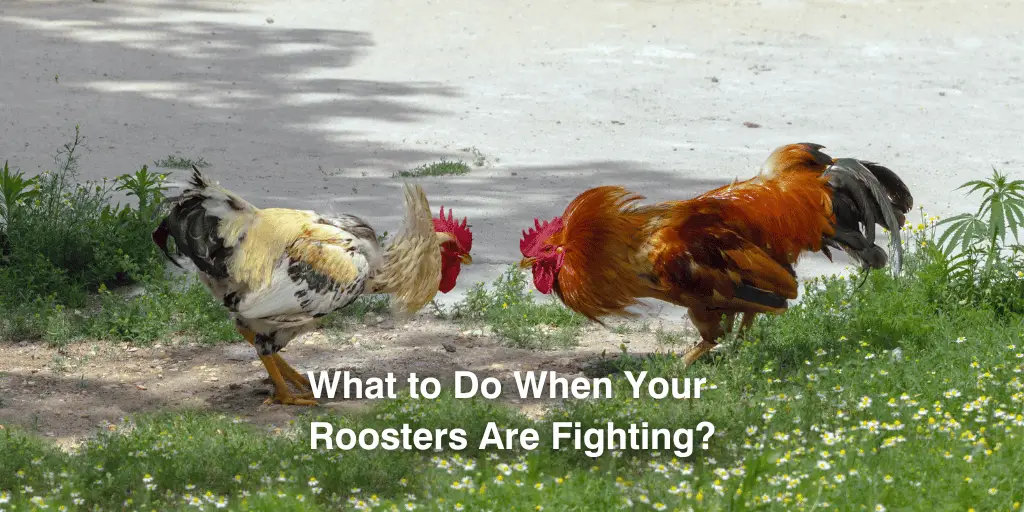Are you feeling anxious about your roosters fighting each other?
Do you want to control your rooster’s fights?
Well! It’s a common problem in every backyard chicken farm. You must know the right method to handle it.
If you are raising chickens, you must know about an aggressive chickens and consequences which may happen in their fight.
This article aims to explain the reasons behind rooster fights and offer effective strategies for managing and preventing them.
Flock owners can create a safer and more peaceful environment for their chickens by using the right interventions.
Also read: All chicken behaviors guide with list
Introduction
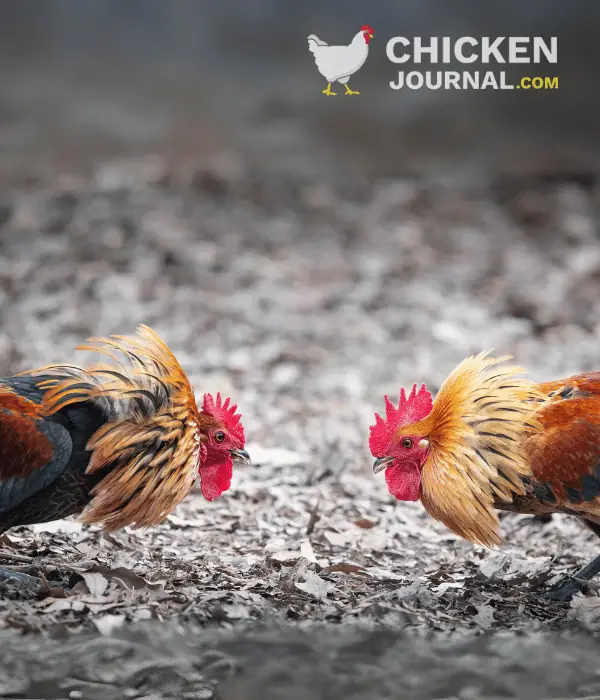
The roosters engage in fights to establish dominance and pecking order among the flock. It’s natural for chickens to compete for their territory, resources, and mating.
In mixed chicken flocks, disputes mostly happen when multiple roosters fight for controlling hens.
Environmental factors can also cause aggressive behaviors. Overcrowding or lack of resources are common reasons.
Some rooster breeds are more prone to fighting because of their aggressive gene.
Massive fights can cause injuries, stress, and even fatalities, which may disturb the flock’s balance.
Never neglect this type of things because it is bad for both egg production and the overall welfare of the chickens.
Why Do Roosters Fight?
Here is detailed information on the causes of roosters fighting.
1. Natural Dominance & Pecking Order
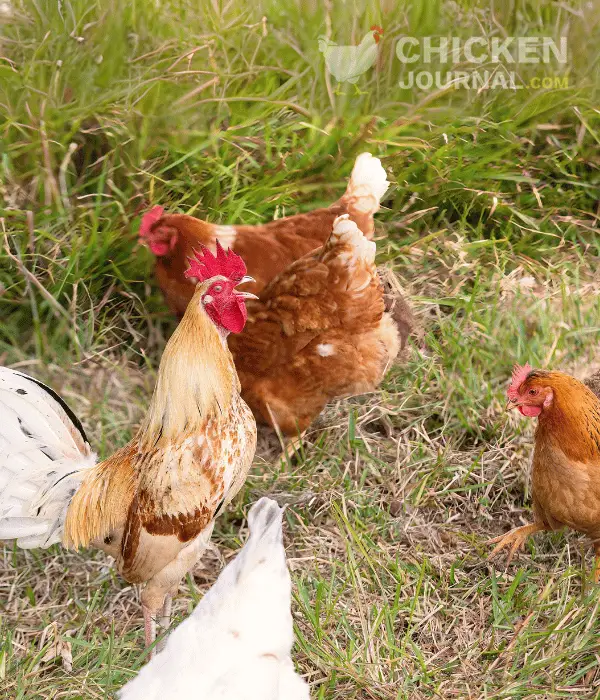
Similar to other animals, roosters maintain a pecking order to establish social hierarchy in the flock.
By showing this powerful behavior, chickens maintain their hierarchy and reduce their long-term issues.
When introducing new cockerels to a new flock, they may engage in small fights to establish dominance.
The fights are short, comprising posturing, chest bumping, or wing flapping. After confirming the pecking order, the dominant rooster assumes leadership and the others follow him.
However, introducing new birds or the death of a leader can cause problems in the present pecking order and start new fights.
2. Conflicts Over Territory
Roosters possess an inherent inclination towards their territory. It drives them to engage in fights to defend their space.
Small coop or run with limited space, drinkers, and feeders can lead to aggression in chickens.
Every rooster desires to create their own territory where they maintain their power and forage with their hens.
When kept in small spaces, even peaceful chicken breeds may become aggressive and attack each other.
In chicken farming, maintaining the right coop size is most important to reduce roosters fights.
3. Rights to Mate
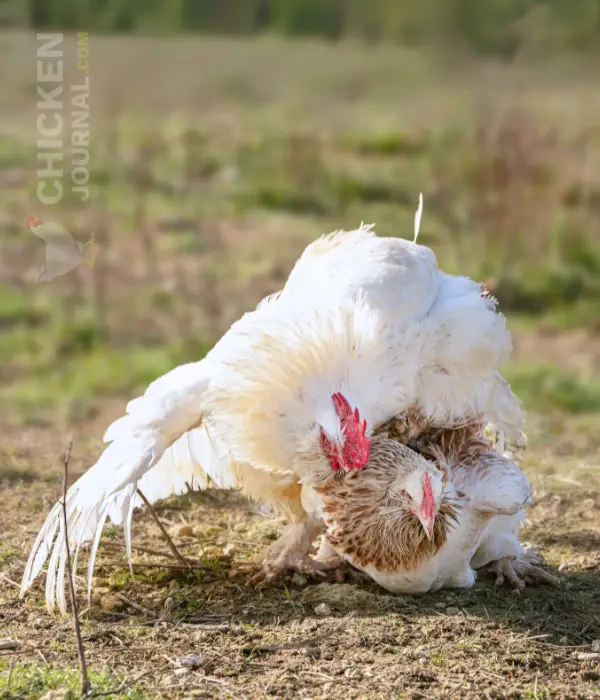
Roosters often fight because of competition for hens. The alpha rooster protects its mating privileges by chasing away other roosters.
When there are too many roosters or the wrong rooster hen ratio, the fighting become more intense.
To reduce competition, experts advise to keep a ratio of 10-12 hens to one rooster.
Fewer hens can cause frequent fighting among roosters, leading to stress and injuries in the flock.
4. The Breed Temperament
A rooster’s temperament usually depends on its breed or genes. Asil, Malay, and Old English Game-fowl breeds exhibit a naturally more aggressive temperament because of their development from other fighting chickens.
However, breeds such as Cochin, Orpington, and Brahma are more calm. It is important to factor in breed traits when managing multiple roosters.
Aggressive roosters fighting is more likely when placed together, while calmer breeds coexist peacefully.
5. Impact of Environmental Stress
Stressful conditions like overcrowding, poor nutrition, or sudden changes in the environment can cause aggressive behavior in roosters.
When birds don’t have enough space to explore, they become irritable and more prone to fighting. Similarly, competition for food or water can increase tensions.
Even external factors like predators, bad weathers, or loud noises can disturb the flock, leading to agitation and fights.
Providing sufficient space, multiple feeder, and waterers with a calm environment helps to reduce stress and fighting in chickens.
How to Identify Signs of Aggression?
To understand a chicken’s aggression, it’s important to recognize common signs and symptoms.
1. Pre-fight Behaviors in Roosters
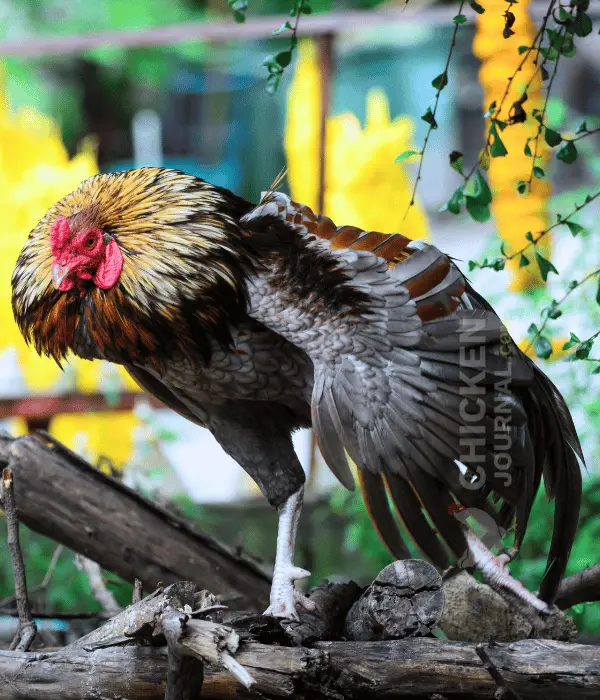
Roosters show a range of warning behaviors before getting into a fight.
Intimidation, dominance, and confrontation avoidance drive these behaviors.
Early recognition of these signs prevents harmful fights.
Chest Bumping
Chest bumping is a common pre-fight behavior in roosters, where they slam their chests together. This behavior signals dominance in roosters.
Mostly seen in young roosters or cockerels when they determine their position in the flock’s hierarchy.
If neither rooster backs down, chest bumping can lead to a more serious fight with pecking and kicking.
Wing Flapping
Flapping wings is a display of aggression in chickens. Roosters stand tall and flap wings to assert dominance.
This behavior is both a display of strength and a warning. They often puff up their feathers and stand rigidly.
Refusing to retreat often leads to physical combat. This behavior warns other roosters to stay away, showing territorial claims.
Crowing Contests
Crowing contests are loud rooster competitions where they try to out-crow each other.
Roosters use crowing to establish dominance, usually the loudest or most persistent one.
These contests usually take place early in the morning or when multiple roosters are foraging nearby.
Crowing contests show tension among males. Without a clear winner, the contest can turn into aggression and fight.
2. Behaviors During a Rooster Fight
Rooster confrontations escalate into aggressive physical fights. Recognizing these behaviors helps owners prevent serious fights.
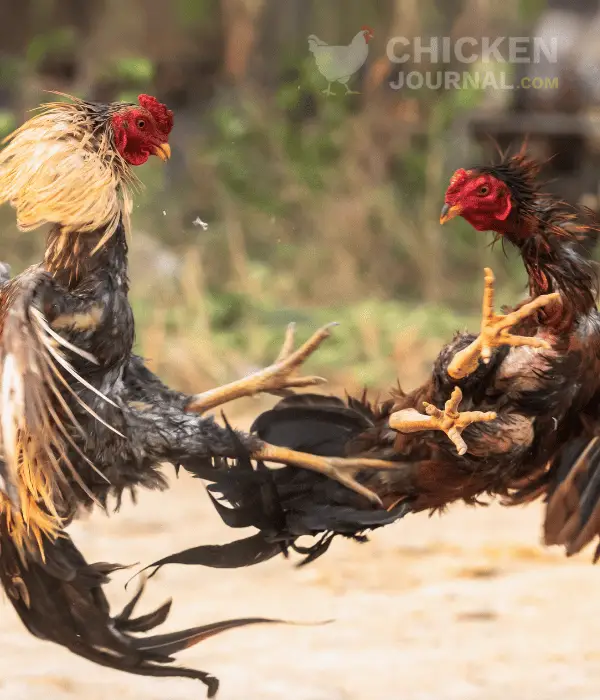
Here are the key signs to look for during a rooster fight.
Spur Strikes
Roosters use their sharp spurs as weapons in fights. Their goal is to strike with spurs as they jump and kick at their opponent.
Rooster fights can lead to deep cuts and bleeding from spur strikes. Using spurs can lead to severe injuries or death if the fight is not stopped.
To reduce injuries, backyard chicken farmers can trim spurs.
Feather Pulling
Chickens pull out each other’s feathers with their beaks during fights.
It’s not only an attack but also a tactic to weaken and dominate the opponent.
Pulling feathers can cause pain and infection if left untreated. Feather pulling during prolonged fights can cause bald spots and stress in chickens.
Loud Screeching or Chasing
Roosters screech loudly during fights to signal distress or rage.
This vocalization often accompanies aggressive chasing, where one rooster relentlessly pursues the other around the coop or run.
Chasing signifies the battle has moved beyond dominance and now centers on personal or territorial matters.
If one rooster tries to escape but the other doesn’t give up, they will probably continue fighting until one bird hurts or isolates the other.
3. Post-fight Signs in Roosters
Fights in roosters result in visible and behavioral changes. Knowing these post-fight indicators is crucial for caring for injured birds and preventing future fights.
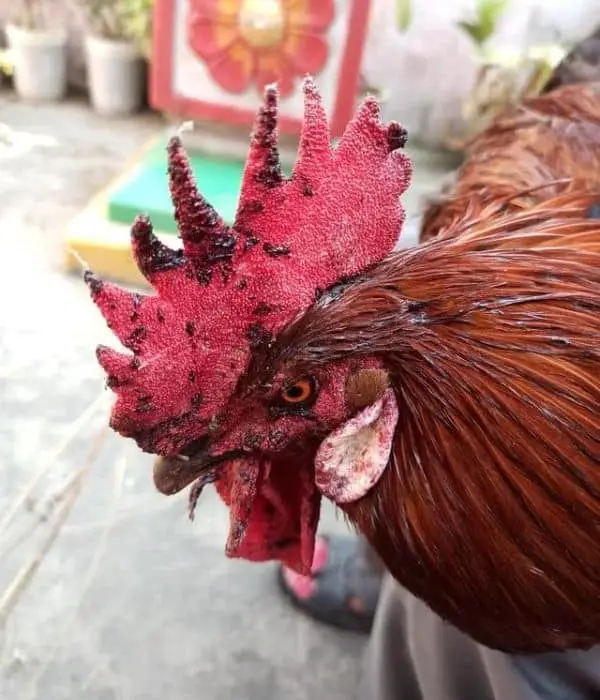
Keep an eye out for these two post-fight signs:
Injuries (Cuts, Swelling, Bleeding)
Physical injuries are most common when chickens fight. These can include:
- Beak attacks or sharp spurs causing cuts and scratches.
- Swelling, bleeding and bruising, particularly on the face, comb, and wattles.
- Bleeding wounds on head, chest, or legs.
Untreated injuries can lead to infections, especially in chickens prone to pecking open wounds.
Use antiseptic or saline solution on cuts to prevent infection. Injured birds may need to be isolated for recovery.
Owners should regularly inspect the flock to prevent bullying or re-injury with the rooster.
Isolation or Submissive Behavior
Losing a fight often leads roosters to display isolation or submissive behavior. A defeated rooster may isolate itself to avoid further conflict.
Examples of submissive behavior may be:
- Head or tail feathers drooping.
- Ignoring or avoiding other birds when they approach.
- Decreased activity, no intake of food or water.
Isolation can reflect fear, trauma, or exhaustion. We may need to separate the injured rooster into a quiet area temporarily for recovery.
If a rooster is submissive for too long, others may bully it, requiring intervention to prevent harm.
How to Handle or Stop Roosters Fighting?
Quick action is necessary to avoid serious injuries in rooster fights. Breaking up a fight can be tricky and harmful if done carelessly.
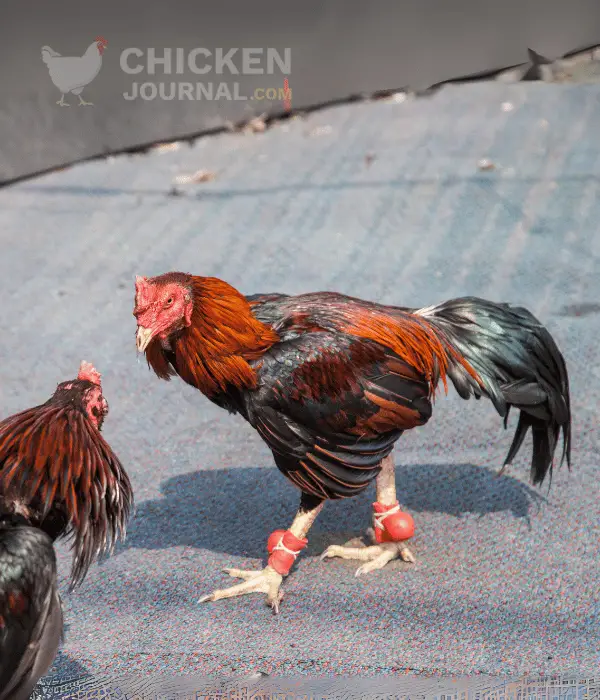
These are safe and effective techniques for separating fighting roosters.
1. Safely Intervene by Using a Broom or Water Hose
You can use a broom to separate the roosters without getting too close. Spraying birds with water can distract them and help separate them.
Maintaining a safe distance, non-contact methods are especially useful for intense fights.
2. Cover the Roosters With a Light Blanket
Covering the birds with a light blanket or towel can disorient them. The sudden environment change pauses the fight.
It’s easier to catch or separate them when they’re under the blanket.
3. Place a Barrier, Such as a Crate or Board, Between Them
Place a large object between the roosters to block their view. You can also place one bird in a holding pen or cage.
Separating them physically prevents further attacks and helps them calm down.
4. Protect Yourself by Wearing Gloves
To handle roosters safely, wear thick gloves or protective clothing to protect against their spurs and beaks.
When picking up a fighting rooster, grasp its body and wings to prevent flapping and kicking.
Stressed roosters can unpredictably lash out, even at their owners, so prioritize safety.
How to Treat Injured Roosters?

Use antiseptic or saline solution to clean wounds.
To minimize the risk of infections, it is important to apply wound ointment.
Separate injured roosters to avoid further bullying.
5 Techniques to Prevent Future Rooster Fights
1. Keep the Rooster-to-Hen Ratio Balanced
Maintain a ratio of 10-12 hens per rooster for reduced mating competition. Too many roosters can cause constant challenges and aggression.
If you own multiple roosters, make sure you have enough hens to keep them occupied.
2. Ensure Sufficient Space and Resources
Provide enough coop and run space to prevent territorial disputes. Provide 5-6 square feet per chicken.
Reduce resource competition by providing multiple feeders and water stations.
3. Choose Rooster-Friendly Breeds
Cochin, Orpington, and Brahma breeds are known for their docility. Don’t keep aggressive breeds like Asil or Malay together to prevent fights.
4. Gradually Introduce Roosters
Quarantine the new rooster before introducing him to the flock. Set up fencing or dividers to promote bird familiarity without conflict.
5. Early Monitoring and Intervention
Observe pre-fight behaviors like chest bumping, wing flapping, or crowing contests.
When tension escalates, briefly separate the roosters or use treats and chicken toys to divert their mind.
These strategies can help you prevent fights and create a peaceful atmosphere for your chickens.
6. When to Think About Permanent Separation or Re-Homing
Permanent separation may be required for some roosters. Move one rooster if the fights are uncontrollable. Create separate pens for roosters without hens.
Conclusion
Managing rooster’s fights in the backyard is most important. Long-term fights between roosters can cause injuries, stress, and disrupt flock stability.
You must know the root causes of the rooster fights like competition and territory can reduce conflict among them.
Poultry farmers can prevent fights from escalating by understanding the pre-fight signs and manage safely.
Quickly treat the injuries and observe the defeated rooster for signs of stress after a fight.
Prevent rooster and cockerel fights by keeping right rooster and hen ratios.
Also, provide correct spacing, selecting calm rooster breeds, introducing new one gradually, and monitoring their temperament.
Considering these things reduce chicken fights, provides a safer space for flocks. I hope this guide helps you in controlling your roosters fighting.
